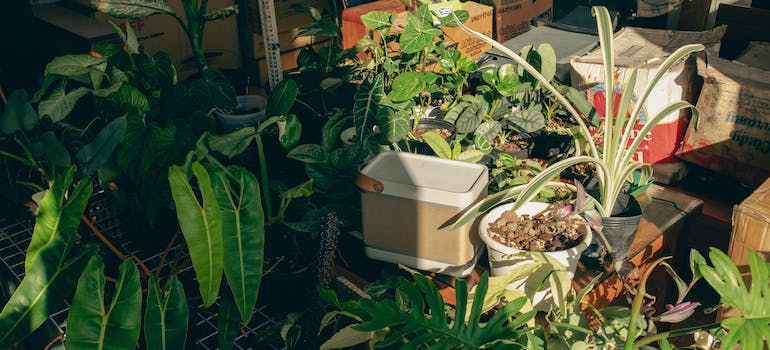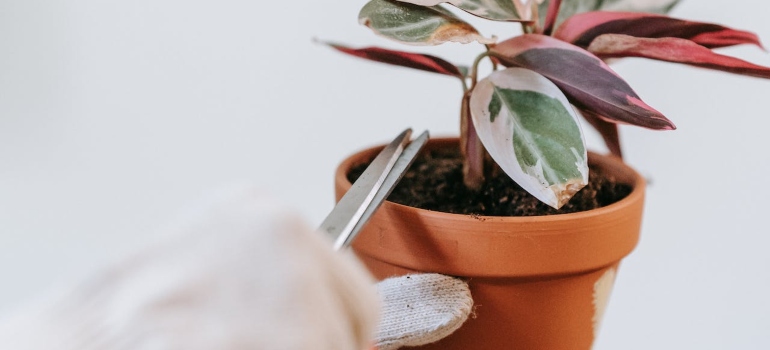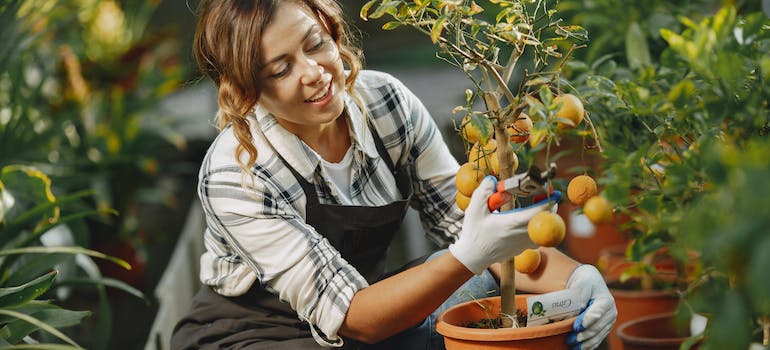Moving with Plants in Idaho: How to Ensure They Arrive Healthy
The task of moving with plants in Idaho necessitates a strategic approach. Unlike inanimate objects, plants are living entities that respond acutely to changes in their environment. Hence, this sensitivity makes the process of relocating them to Idaho’s distinct climate a mission requiring careful planning and execution. The goal is to maintain the health and vitality of these green companions, ensuring their smooth acclimatization to their new environment. The following Idaho movers‘ article provides essential guidelines and innovative strategies for transporting your indoor and outdoor plants successfully.
Understanding Idaho’s Climate for Plant Relocation
From the semi-arid southern plains to the cooler, mountainous regions in the north, understanding climate variability is crucial for ensuring the health and survival of your plants during and after the move.
Temperature Adaptation
Idaho’s temperature range is broad, with significant variations between seasons and regions. For instance, according to U.S. Climate Data, cities in southern Idaho, like Boise, experience hot summers with temperatures often soaring above 90°F, while winters can dip below freezing. In contrast, northern areas like Coeur d’Alene have milder summers and colder, snowier winters.
This wide temperature range means that plants need to be gradually acclimated to their new environment. For indoor plants, this could involve adjusting the thermostat over several days to replicate the new external conditions they will face. For outdoor plants, protective measures such as frost cloths or plastic tents are beneficial during the initial days post-relocation, especially in areas with extreme temperature fluctuations.

Humidity Considerations
Humidity levels in Idaho also vary significantly. The southern part of the state, as per the National Weather Service’s Southeastern Idaho Climate Graphs, tends to have drier air, which can be challenging for plants accustomed to higher humidity. In contrast, the northern regions, with their higher precipitation levels, as indicated in the State Climate Summaries 2022, offer a more humid environment.
For plants moving from more humid to drier areas, strategies to increase ambient moisture are essential. Regular misting can help, but for a more consistent solution, using a humidifier can maintain an optimal humidity level. Grouping plants together can also create a microenvironment with higher humidity, which is beneficial for plants that thrive in moist conditions.
Precipitation Patterns
Precipitation in Idaho varies widely, with the state experiencing both extremely dry and wet years. The driest year on record was 1935, with a total of 16.2 inches of precipitation, while the wettest was 1996, with 32.10 inches, as noted in the Idaho State Climate Summaries 2022. This variability in precipitation means that watering practices for plants may need to be adjusted based on the current year’s trends and the specific region within Idaho.
Hardiness and Soil Quality Considerations
Just as your belongings may require temperature-controlled storage in Boise to maintain their shape, your plants need the right environmental conditions to thrive during the transition to their new home.
Plant Hardiness Zones
Idaho spans several plant hardiness zones, a standard by which gardeners and growers can determine which plants are most likely to thrive at a location. The state’s zones range from 3b in the colder mountainous regions to 7b in the warmer southern areas. This information is crucial for determining if a plant can survive the winter temperatures of the area you’re moving to.
For instance, a plant that thrives in the mild winters of hardiness zone 7b may struggle in the harsher conditions of zone 3b. Before moving, check the USDA Plant Hardiness Zone Map or local resources to ensure your plants are suitable for the specific zone in Idaho where you’ll be relocating.

Soil Quality and Composition
Soil quality in Idaho varies greatly due to its diverse geography. The state’s soil ranges from rich, volcanic soil in some northern areas to more arid, sandy soil in the south. Understanding the soil composition of your new location is vital for plant health.
For example, plants that prefer well-draining, sandy soil will do well in southern Idaho, while those that need richer, more nutrient-dense soil may be better suited to northern regions. Before you move your inanimate belongings with interstate movers Boise offers, it’s advisable to research the soil type of your new area and prepare accordingly. This might involve:
- Amending the soil with organic matter,
- Adjusting pH levels or
- Choosing plants that are well-adapted to the existing soil conditions.
Additionally, consider the soil’s moisture retention capacity, especially in areas with lower precipitation. Plants that require more moisture may need more frequent watering or soil amendments to improve water retention.
Pre-Move Plant Preparation
The preparation phase, starting weeks before the move, is crucial for minimizing stress and shock to the plants, so take a look at what it involves:
- Pruning and Health Check: Trim overgrown branches, remove dead or dying leaves, and check for signs of pests or diseases.
- Soil and Watering: Water your plants thoroughly a few days before the move, but avoid overwatering to prevent root rot.
- Pest Prevention: Treat any signs of pests with appropriate, non-toxic remedies to prevent infestations during the move.
- Acclimatization: Gradually adjust your plants to the light and temperature conditions they will experience in their new home.
- Fertilization: Avoid fertilizing plants right before the move, as this can cause unnecessary stress.
- Root Care: For larger plants, ensure the root ball is adequately moistened and protected.
- Labeling: Label each plant with its name and specific care instructions for easy identification and care post-move.
A thorough pre-move preparation is beneficial for several reasons. It ensures that plants are in optimal health before they undergo the stress of moving. Proper pruning and health checks can prevent the spread of diseases and pests. Adequate watering and acclimatization help plants adjust more quickly to their new environment, reducing the risk of transplant shock. This careful attention to detail ensures that your plants remain vibrant and healthy throughout the moving to Idaho process.

Packing and Moving with Plants in Idaho
Packing your plants correctly is crucial for their survival during the move. The right packing methods protect plants from physical damage, dehydration, and environmental stress:
- Proper Containers: Use lightweight plastic containers for easier handling and reduced risk of breakage.
- Stabilizing the Plant: Secure the soil with damp newspapers or bubble wrap to prevent spilling and retain moisture.
- Protecting Foliage: Wrap delicate foliage and branches with soft materials to prevent breakage.
- Maintaining Moisture: Cover the topsoil with plastic to retain moisture during the move.
- Temperature Control: If possible, transport plants in a temperature-controlled environment, especially for sensitive species.
- Upright Positioning: Ensure plants are kept upright and securely positioned to prevent tipping.
- Sunlight Exposure: Consider the amount of sunlight plants will receive during transport and adjust accordingly.
Proper packing of plants offers numerous benefits. It reduces the risk of physical damage during transit and helps maintain optimal moisture levels. If you protect the foliage and ensure the right environmental conditions, plants are less likely to suffer from stress or shock. This careful packing ensures that your plants arrive at their new home in the best possible condition, ready to thrive in their new environment.
Post-Move Care in Idaho
Once your belongings have arrived in Idaho with moving services Boise ID offers, and your plants with you, the care they receive is crucial for their successful adaptation to the new environment:
- Gradual Exposure: Slowly introduce your plants to their new environment. For outdoor plants, start with a few hours of outdoor time, gradually increasing each day.
- Monitoring and Adjustment: Regularly inspect your plants for signs of stress, such as wilting, discoloration, or leaf drop. Adjust their watering schedules and placement based on their response to the new conditions.
- Soil Assessment: Check the soil quality and pH levels, adjusting them if necessary to suit the specific needs of your plants.
- Climate Adaptation: Before moving with plants in Idaho, be mindful of Idaho’s varied climate. Adapt your plant care routine accordingly, especially during seasonal changes.
- Fertilization: Once your plants have settled, consider a light fertilization to provide essential nutrients and encourage growth.
Attentive post-move care ensures that your plants recover from the stress of relocation and adapt to their new environment. Gradual exposure to new conditions helps prevent shock, while regular monitoring allows for timely interventions to address any issues.

Consider Local Idaho Regulations
When relocating plants to Idaho, it’s important to be aware of the state’s agricultural regulations. These regulations are in place to protect local ecosystems from invasive species and diseases:
- Quarantines: Idaho has specific quarantines that may apply to plants moving into or within the state. These are designed to prevent the spread of pests and diseases.
- Permits: Some plants might require special permits, especially when moving from out of state.
- Restricted Species: Be aware of any plant species that are restricted or prohibited in Idaho to avoid legal issues.
Complying with local regulations on plant quarantine before moving with plants in Idaho is essential for several reasons. It helps in preserving Idaho’s native flora and fauna, prevents the introduction of invasive species, and ensures that your relocation process is smooth and legally compliant. Being informed and adhering to these regulations is a responsible step towards protecting Idaho’s diverse and unique ecosystems.
Utilize Local Resources
Tapping into local resources in Idaho is a strategic move for anyone relocating plants. Local nurseries, gardening communities, and extension services are treasure troves of information and support, offering insights and advice tailored to Idaho. Why does local expertise matter?
Tapping into the expertise of local professionals in Idaho offers a wealth of benefits for anyone looking to relocate plants successfully. Just as long distance movers in Boise expertly transport your items, so do plant specialists possess a deep understanding of the region’s specifics.

Additionally, their guidance in selecting the right plants for your specific area in Idaho can be crucial. They can recommend species that are well-suited to thrive in the local environmental conditions, ensuring a lush garden in your new Idaho home. So, how do you leverage local resources?
- Visit Local Nurseries: These are great places to get advice on plant care and to purchase plants that are well-suited to the local climate.
- Join Gardening Groups: Local gardening clubs or online forums can be excellent sources of tips and support from fellow plant enthusiasts.
- Attend Workshops and Events: Look out for gardening workshops, lectures, or community events focused on plant care and gardening in Idaho.
- Consult Extension Services: Universities and agricultural extension services often offer resources and expert advice on a wide range of gardening topics.
Utilizing local resources when relocating plants in Idaho comes with several advantages. You gain access to a wealth of knowledge specific to the region, which can significantly enhance your ability to care for your plants effectively. Engaging with local gardening communities also provides an opportunity to connect with like-minded individuals, offering a sense of belonging.
Flourishing in Idaho: A Green Transition
In essence, moving with plants in Idaho offers a unique opportunity to integrate into the rich and diverse Idaho ecosystem. Focus your attention on Idaho’s unique climate and the utilization of invaluable local insights. With careful preparation, your plants will not only survive but truly flourish. This process nurtures a deeper connection with your new environment, transforming your space into a thriving green oasis in the heart of the Gem State.

Everyone from the packers to the movers were awesome! They were all very professional and showed up when they were supposed to. would definitely use them again.

